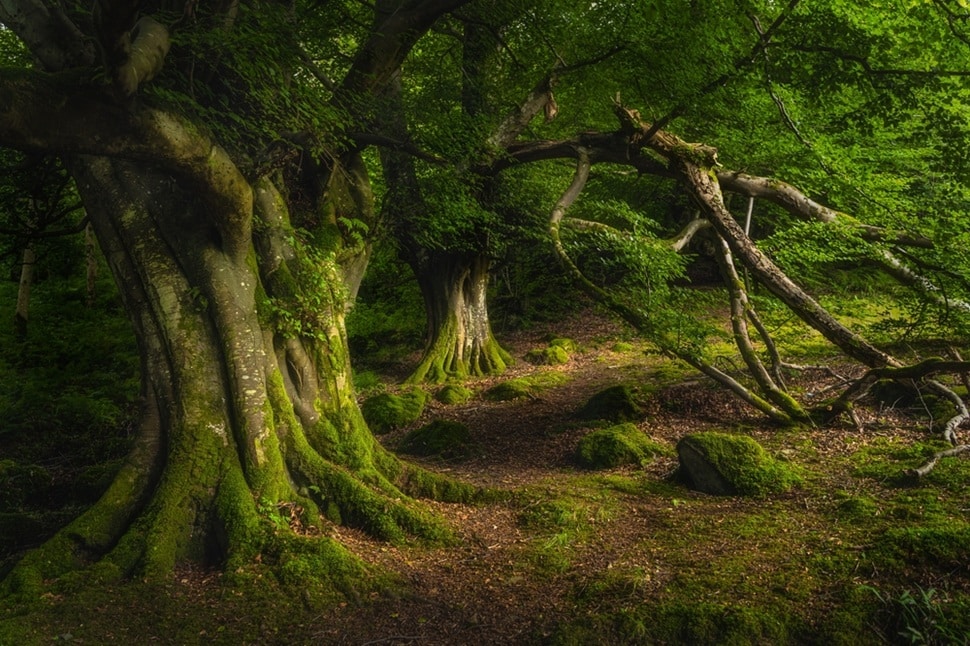
Walk along a country lane, and you’ll probably take hedgerows for granted: a stretch of hawthorn here, a hazel there, blackthorn blossom in spring. But hedgerows are much more than field boundaries. There are currently half a million miles of hedgerows in Great Britain and Northern Ireland that provide living, dynamic habitats: mini-woodlands and corridors for wildlife that stitch vast acres of the countryside together.
After dramatic hedgerow losses in the 20th century due to the onset of intensive farming, the art of planting hedgerows is reviving: farmers, charities and government schemes are helping the UK’s living fences recover, and that matters for wildlife, soil, pollination and climate resilience.
This article explains why hedgerows are an important part of our heritage, which species depend on their vital habitat, the policies and payment schemes helping farmers plant and manage hedges, and examples of on-the-ground success in the UK.
Why hedgerows matter: key points
Hedgerows are multi-functional; as well as looking beautiful in their own right, they have many other uses in our countryside including:
- acting as commuting routes across farmland, allowing species to move safely between woodlands and fields to forage, breed and shelter;
- providing food sources such as nectar-rich flowers, along with berries and nuts from other plants in late summer;
- offering nesting sites for birds, mammals and insects;
- supporting pollinators and pest-eating insects that benefit crops;
- preventing soil loss through erosion; hedges also reduce flooding by slowing water run off and helping regulate water supply;
- sequestering carbon in woody biomass and soils helping counter climate change;
- reducing wind speed across land, providing shelter for farm animals and a wide range of species;
- originally planted to contain livestock, hedges provide natural barriers across the countryside.
Views of nature organisations and research
The Woodland Trust notes that rural hedgerows are often a mix of shrub and tree species: native trees in hedgerows often comprise hawthorn, blackthorn which produces sloes for making sloe gin, hazel, ash, crab apple, wild cherry and oak, and can host large numbers of plant, fungi and animal species.
As the RSPB points out, hedges help create more productive farmland because beneficial insects living in them pollinate crops and help control pests. Good hedges work for wildlife and for farmers; they lock up and store carbon helping mitigate the impact of climate change, they act as natural barriers to reduce flooding, soak up rainwater and are beneficial in reducing pollution.
A recent University of Oxford study found that trees and hedges on farmland significantly boost butterfly numbers, showing the measurable biodiversity uplift hedges can provide in otherwise species-poor agricultural landscapes.

What different species depend on hedges?
Hedgerows are ecosystems in miniature, providing widespread semi natural habitat. They support hundreds of species including:
- Birds: warblers, finches, robins, yellowhammers, linnets, blue tit and bullfinches use hedges during the nesting season and for shelter and food from fruiting tree species such as crab apple. The RSPB notes that many farmland bird declines are linked to the removal of hedgerows.
- Invertebrates: bees, hoverflies, beetles, moths and butterflies rely on nectar, pollen and the structural variety of different types of hedgerow. Hedgelink, which connects organisations involved in hedgerows, identifies 130 priority species in the UK Biodiversity Action Plan heavily associated with hedges.
- Small mammals & bats: mice, voles and shrews use hedgerows as foraging and commuting routes; bats hunt along hedgerow edges at dusk.
- Plants & fungi: diverse ground flora, mosses and mycorrhizal fungi shelter in the shady, undisturbed bank soils. Ancient hedges can host veteran trees and a rich understorey. The Woodland Trust and other groups emphasise the huge species value packed into old hedges and ancient woodland.

Why hedgerows declined rapidly – and why they’re returning
Hedgerow removal got underway in the mid-20th century. Hedges were stripped out en masse to create larger fields for mechanised agriculture and the use of agricultural chemicals as intensive farming got underway. Estimates suggest nearly half the hedgerow network was lost in the British countryside between the 1940s and 1990s. That removal of hedgerows severed wildlife corridors and reduced available habitat.
Since the 1990s conservation groups and some farmers began reversing the trend. More recently, political and policy support has strengthened: the UK government and agencies have reinstated legal protections and launched funding streams to encourage the planting and restoration of hedgerows.
Boosting hedgerows survival and renewal
The Management of Hedgerows (England) Regulations 2024 tightened protection for hedgerows on or next to agricultural land and set rules on when and how hedges can be cut, trimmed or removed.
Hedgerow charities and partnerships (notably Hedgelink, which brings together non-governmental organisations, businesses and nurseries) are coordinating planting campaigns and training volunteers in traditional skills such as laying hedges.
A national push aims to create or restore 45,000 miles of hedgerow by 2050; a high-profile target that’s been widely reported on and welcomed by conservationists.

What helps hedgerows flourish: payments and incentives for farmers
Financial incentives have been crucial to making different types of hedgerow restoration viable on working farms. Key schemes include:
- Countryside Stewardship (England) which offers specific hedgerow options such as Hedgerow gapping-up (BN7) and Hedgerows and Boundaries grants to support hedgerow planting, replacement, and management. Payments cover planting costs and ongoing hedgerow maintenance. The BN7 option, for example, pays per metre for gapping up existing boundary hedges.
- Hedgerow management rules under the new 2024 regulations set minimum standards for trimming and buffer strips to protect wildlife and are backed by guidance from government agencies and Natural England. These hedgerow regulations help ensure that payments link to good practice and that hedges are kept in wildlife-friendly condition.
- Local and charity programmes: many Wildlife Trusts, county councils and partnerships run grant schemes or match-funding to help landowners plant hedgerows, train workers in the art of laying hedges and instal guard tubes or stock fencing. Hedgelink lists funders and resources for those keen to apply.
These incentives make hedgerow planting financially realistic for farms of different sizes, while linking payments to agreed standards and hedgerow regulations that maximise environmental gains.

Good practice: what makes a hedgerow wildlife-friendly?
Quality matters as much as quantity. Research and on-the-ground guides emphasise structural diversity: the ideal natural shape for a hedge includes a wide base, mixed woody species, an intact bank, and an adjacent grass margin which all boost biodiversity. A review paper concluded that hedgerow structural diversity is key to increasing their benefits for wildlife and ecosystem services.
Practical measures farmers and land managers use include:
- Gapping-up with native shrubs (hawthorn, blackthorn, field maple, hazel, spindle) rather than single-species hedges;
- Maintaining a buffer strip of grass alongside the hedge for pollen, nectar and invertebrate habitat;
- Hedgerow laying to rejuvenate over-grown hedges and create dense habitat for nesting birds;
- Staggered cutting rotation to leave nesting cover in some years and keep flowering in others;
- Leaving veteran trees and hedgerow trees where possible: these are biodiversity hotspots creating habitat for a wealth of species. Hedgerows with mature trees are especially valuable.

Examples of successful UK schemes
- Dartmoor, East Anglia and other restoration hotspots: community and trust projects have re-laid hedges and replanted thousands of metres of boundary hedge, often combining cultural skills and volunteer labour to restore ancient patterns.
- Countryside Stewardship projects nationwide: many farms use BN7 and hedgerow grant packages to rejuvenate boundaries; the practical manuals and guidance help ensure planting is done to ecological standards.
- Hedgelink coalition: this partnership plays a major role in supporting a nursery supply of whips or young saplings, technical guidance, and national coordination, helping connect landowners to funding, plants and skilled hedge-layers. Hedgelink also compiles best practice and funding information for managers.
- The Oxford study mentioned above showed that hedges boost butterfly abundance, underlining that even relatively small, well-placed hedgerows can deliver measurable biodiversity returns across working landscapes.

Hedgerows UK: challenges and trade-offs
Restoring hedgerows is not without obstacles including funding and labour: hedge planting and hedge laying require investment and there is a national shortage of skilled hedge layers.
Farm economics also come into the equation; some farmers worry about losing productive land. While there are payment schemes that aim to offset that, uptake varies.
There are also long timescales involved. Hedges take years to develop into rich wildlife habitats and veteran hedgerow trees take decades: the process demands long-term commitment to hedgerow maintenance.
Add to this the legal and practical complexity: new hedgerow regulations (Management of Hedgerows Regulations 2024) create obligations that land managers must understand and follow.

What readers can do
You don’t have to be a farmer to help hedgerows:
- Plant a native hedge in your garden or community space and use locally sourced native species that are a proven popular choice. Hedgelink and The Woodland Trust provide species lists and planting guides.
- Support local conservation groups or volunteer on hedge laying days.
- Ask your local council to protect roadside hedges and create hedge-friendly verges.
- If you farm, look into Countryside Stewardship hedgerow planting options and local grants.

Thriving hedges offer great value to the countryside
Over the last thousand years, many hedgerows were planted in the first instance to form natural field ownership boundaries, but they also happen to be wildlife superhighways. Restoring and caring for them delivers a host of climate change benefits: hedgerows regulate water supply enabling better flood resilience and they provide opportunities for richer wildlife, healthier soils, pollination and pest control for farms and lock carbon away into wood and soil.
The policy tools and volunteer energy are now in place to scale up hedgerow recovery, but success will depend on sustained funding, skilled labour, and practical support for landowners.
If we treat hedges as living assets rather than tidy field boundaries, Britain’s countryside can become greener, wilder and more productive at the same time. Hedgerows are part of our cultural heritage and historical record as well as being an iconic element of the British countryside.
Restoring the current half a million miles of hedgerows as well as planting new hedges could be the catalyst for one of the most effective revolutions in nature recovery.



